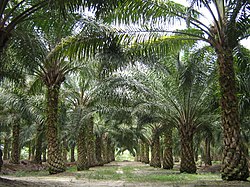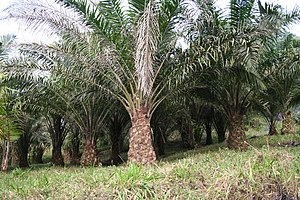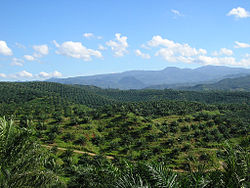From Wikipedia, the free encyclopedia
Palm oil (also known as dendê oil, from Portuguese) is an edible vegetable oil derived from the mesocarp (reddish pulp) of the fruit of the oil palms, primarily the African oil palm Elaeis guineensis,[1] and to a lesser extent from the American oil palm Elaeis oleifera and the maripa palm Attalea maripa.
Palm oil is naturally reddish in color because of a high beta-carotene content. It is not to be confused with palm kernel oil derived from the kernel of the same fruit,[2] or coconut oil derived from the kernel of the coconut palm (Cocos nucifera). The differences are in color (raw palm kernel oil lacks carotenoids and is not red), and in saturated fat content: Palm mesocarp oil is 41% saturated, while Palm Kernel oil and Coconut oil are 81% and 86% saturated respectively.[3]
Along with coconut oil, palm oil is one of the few highly saturated vegetable fats and is semi-solid at room temperature. Like other vegetable oils, palm oil contain zero cholesterol.[4]
Palm oil is a common cooking ingredient in the tropical belt of Africa, Southeast Asia and parts of Brazil. Its use in the commercial food industry in other parts of the world is widespread because of its lower cost[5] and the high oxidative stability (saturation) of the refined product when used for frying.[6][7]
The use of palm oil in food products has attracted the concern of environmental activist groups; the high oil yield of the trees has encouraged wider cultivation, leading to the clearing of forests in parts of Indonesia in order to make space for oil-palm monoculture. This has resulted in significant acreage losses of the natural habitat of the orangutan, of which both species are endangered; one species in particular, the Sumatran orangutan, has been listed as "critically endangered".[8] In 2004, an industry group called the Roundtable on Sustainable Palm Oil (RSPO) was formed to work with the palm oil industry to address these concerns.[9] Additionally, in 1992, in response to concerns about deforestation, the Malaysian Government pledged to limit the expansion of palm oil plantations by retaining a minimum of half the nation's land as forest cover.[10][11]
History
Human use of oil palms may date as far back as 5,000 years; in the late 1800s, archaeologists discovered a substance that they concluded was originally palm oil in a tomb at Abydos dating back to 3,000 BCE.[12] It is believed that Arab traders brought the oil palm to Egypt.[13]
Palm oil from Elaeis guineensis has long been recognized in West and Central African countries, and is widely used as a cooking oil. European merchants trading with West Africa occasionally purchased palm oil for use as a cooking oil in Europe.
Palm oil became a highly sought-after commodity by British traders, for use as an industrial lubricant for machinery during Britain's Industrial Revolution.[14]
Palm oil formed the basis of soap products, such as Lever Brothers' (now Unilever) "Sunlight" soap, and the American Palmolive brand.[15]
By around 1870, palm oil constituted the primary export of some West African countries such as Ghana and Nigeria although this was overtaken by cocoa in the 1880s.[citation needed]
Composition
Fatty acids
Palm oil like all fats, is composed of fatty acids, esterified with glycerol. Palm oil has an especially high concentration of saturated fat, specifically, of the 16-carbon saturated fatty acid palmitic acid, to which it gives its name. Monounsaturated oleic acid is also a major constituent of palm oil. Unrefined palm oil is a large natural source of tocotrienol, part of the vitamin E family.[16]The approximate concentration of fatty acids in palm oil is:[17]
Carotenes
When unrefined or when processed into red palm oil, it is naturally rich in carotenes, which give it its characteristic dark red color. Like tomatoes, carrots and many other fruits and vegetables but unlike most oils, palm oil naturally contains the nutrients alpha-carotene, beta-carotene and lycopene. Palm oil contains other carotenes including tocopherols and tocotrienols (members of the vitamin E family), CoQ10, phytosterols, and glycolipids.[18]Processing and use
Many processed foods either contain palm oil or various ingredients derived from it.[19]Refining
After milling, various palm oil products are made using refining processes. First is fractionation, with crystallization and separation processes to obtain solid (stearin), and liquid (olein) fractions.[20] Then melting and degumming removes impurities. Then the oil is filtered and bleached. Physical refining[clarification needed] removes smells and coloration to produce "refined, bleached and deodorized palm oil" (RBDPO) and free sheer fatty acids,[clarification needed] which are used in the manufacture of soaps, washing powder and other products. RBDPO is the basic palm oil product sold on the world's commodity markets. Many companies fractionate it further to produce palm olein for cooking oil, or process it into other products.[20]Red palm oil
Since the mid-1990s, red palm oil has been cold-pressed and bottled for use as cooking oil, and blended into mayonnaise and salad oil.[21]Antioxidants
Red palm oil antioxidants like tocotrienols and carotenes are added to foods and cosmetics because of their purported health benefits.[22][23][24]Butter and trans fat substitute
The highly saturated nature of palm oil renders it solid at room temperature in temperate regions, making it a cheap substitute for butter or trans fats in uses where solid fat is desirable, such as the making of pastry dough and baked goods. A recent rise in the use of palm oil in the food industry has partly come from changed labelling requirements that have caused a switch away from using trans fats.[25] Palm oil has been found to be a reasonable replacement for trans fats;[26] however, a small study conducted in 2009 found that palm oil may not be a good substitute for trans fats for individuals with already elevated LDL levels.[27] The USDA agricultural research service states that palm oil is not a healthy substitute for trans fats.[28]Biomass and bioenergy
Palm oil can be used to produce biodiesel, which is also known as palm oil methyl ester.[29] Palm oil methyl ester is created through a process called transesterification. Palm oil biodiesel is often blended with other fuels to create palm oil biodiesel blends.[30] Palm oil biodiesel meets the European EN 14214 standard for biodiesels.[29] The world's largest palm oil biodiesel plant is the Finnish operated Neste Oil biodiesel plant in Singapore, which opened in 2011.[31]The organic waste matter that is produced when processing oil palm, including oil palm shells and oil palm fruit bunches, can also be used to produce energy. This waste material can be converted into pellets that can be used as a biofuel.[32] Additionally, palm oil that has been used to fry foods can be converted into methyl esters for biodiesel. The used cooking oil is chemically treated to create a biodiesel similar to petroleum diesel.[33]
In wound care
Although palm oil is applied to wounds for its supposed antimicrobial effects, research does not confirm its effectiveness.[34]Production
As of 2012[update], the annual revenue received by Indonesia and Malaysia together, the top two producers of palm oil, is US$40 billion.[35] Between 1962 and 1982 global exports of palm oil increased from around half a million to 2.4 million tonnes annually and in 2008 world production of palm oil and palm kernel oil amounted to 48 million tonnes. According to FAO forecasts by 2020 the global demand for palm oil will double, and triple by 2050.[36]Indonesia
Indonesia is the largest producer of palm oil, surpassing Malaysia in 2006, producing more than 20.9 million tonnes.[35][37] Indonesia expects to double production by the end of 2030.[9] At the end of 2010, 60 percent of the output was exported in the form of Crude Palm Oil.[38] FAO data show production increased by over 400% between 1994 and 2004, to over 8.66 million metric tonnes.Malaysia

In 2012, Malaysia, the world's second largest producer of palm oil,[39] produced 18.79 million tonnes of crude palm oil on roughly 5,000,000 hectares (19,000 sq mi) of land.[40][41] Though Indonesia produces more palm oil, Malaysia is the world's largest exporter of palm oil having exported 18 million tonnes of palm oil products in 2011. China, Pakistan, the European Union, India and the United States are the primary importers of Malaysian palm oil products.[42]
Nigeria
As of 2011, Nigeria was the third-largest producer, with approximately 2.3 million hectares (5.7×106 acres) under cultivation. Until 1934, Nigeria had been the world's largest producer. Both small- and large-scale producers participated in the industry.[43][44]Thailand
In 2013, Thailand produced 2.0 million tonnes of crude palm oil on roughly 626 thousand hectares.{{FAOStat}}Colombia
In the 1960s, about 18,000 hectares (69 sq mi) were planted with palm. Colombia has now become the largest palm oil producer in the Americas, and 35% of its product is exported as biofuel. In 2006, the Colombian plantation owners' association, Fedepalma, reported that oil palm cultivation was expanding to 1,000,000 hectares (3,900 sq mi). This expansion is being funded, in part, by the United States Agency for International Development to resettle disarmed paramilitary members on arable land, and by the Colombian government, which proposes to expand land use for exportable cash crops to 7,000,000 hectares (27,000 sq mi) by 2020, including oil palms. Fedepalma states that its members are following sustainable guidelines.[45]Some Afro-Colombians claim that some of these new plantations have been expropriated from them after they had been driven away through poverty and civil war, while armed guards intimidate the remaining people to further depopulate the land, with coca production and trafficking following in their wake.[46]
Other countries
Benin
Palm is native to the wetlands of western Africa, and south Benin already hosts many palm plantations. Its 'Agricultural Revival Programme' has identified many thousands of hectares of land as suitable for new oil palm export plantations. In spite of the economic benefits, Non-governmental organisations (NGOs), such as Nature Tropicale, claim biofuels will compete with domestic food production in some existing prime agricultural sites.Other areas comprise peat land, whose drainage would have a deleterious environmental impact. They are also concerned genetically modified plants will be introduced into the region, jeopardizing the current premium paid for their non-GM crops.[47][48]
Cameroon
Cameroon has a production project underway initiated by Herakles Farms in the US.[49] However, the project has been halted under the pressure of Greenpeace, WWF and other civil society organizations in Cameroon. Before the project was halted, Herakles left the Roundtable on Sustainable Palm Oil (RSPO) early on in negotiations. The project has been controversial due to opposition from villagers and the location of the project in a biodiversity hotspot.[50][51]Kenya
Kenya's domestic production of edible oils covers about a third of its annual demand, estimated at around 380,000 metric tonnes. The rest is imported at a cost of around US$140 million a year, making edible oil the country's second most important import after petroleum. Since 1993 a new hybrid variety of cold-tolerant, high-yielding oil palm has been promoted by the Food and Agriculture Organization of the United Nations in western Kenya. As well as alleviating the country's deficit of edible oils while providing an important cash crop, it is claimed to have environmental benefits in the region, because it does not compete against food crops or native vegetation and it provides stabilisation for the soil.[52]Ghana
Ghana has a lot of palm nut species, which may become an important contributor to the agriculture of the region. Although Ghana has multiple palm species, ranging from local palm nuts to other species locally called agric, it was only marketed locally and to neighboring countries. Production is now expanding as major investment funds are purchasing plantations, because Ghana is considered a major growth area for palm oil.Markets
According to the Hamburg-based Oil World trade journal,[citation needed] in 2008 global production of oils and fats stood at 160 million tonnes. Palm oil and palm kernel oil were jointly the largest contributor, accounting for 48 million tonnes, or 30% of the total output. Soybean oil came in second with 37 million tonnes (23%). About 38% of the oils and fats produced in the world were shipped across oceans. Of the 60.3 million tonnes of oils and fats exported around the world, palm oil and palm kernel oil made up close to 60%; Malaysia, with 45% of the market share, dominated the palm oil trade.Food label regulations
Previously, palm oil could be listed as "vegetable fat" or "vegetable oil" on food labels in the European Union (EU). From December 2014, food packaging in the EU is no longer allowed to use the generic terms "vegetable fat" or "vegetable oil" in the ingredients list. Food producers are required to list the specific type of vegetable fat used, including palm oil. Vegetable oils and fats can be grouped together in the ingredients list under the term "vegetable oils" or "vegetable fats" but this must be followed by the type of vegetable origin (e.g. palm, sunflower or rapeseed) and the phrase "in varying proportions".[53]Nutrition and health
Palm oil is also an important source of calories and a food staple in poor communities.[54][55][56] However its overal health impacts, particularly in relation to cardiovascular disease, are controversial and subject to ongoing research.Much of the palm oil that is consumed as food is to some degree oxidized rather than in the fresh state, and this oxidation appears to be responsible for the health risk associated with consuming palm oil.[57]
Cardiovascular disease
Several studies have linked palm oil and cardiovascular disease including a 2005 study conducted in Costa Rica which indicated that replacing palm oil in cooking with polyunsaturated non-hydrogenated oils could reduce the risk of heart attacks,[58] and a 2011 analysis of 23 countries which showed that for each kilogram of palm oil added to the diet annually there was an increase in ischemic heart disease deaths (68 deaths per 100,000 increase) though the increase was much smaller in high-income countries.[59]However, results from several studies indicate that palm oil provides health benefits, including increasing good cholesterol and reducing bad cholesterol, and that consumption of palm oil does not increase the risk of cerebrovascular disease.[60]
Palmitic acid
According to studies reported on by the Center for Science in the Public Interest (CSPI), excessive intake of palmitic acid, which makes up 44 percent of palm oil, increases blood cholesterol levels and may contribute to heart disease.[61] The CSPI also reported that the World Health Organization and the US National Heart, Lung and Blood Institute have encouraged consumers to limit the consumption of palmitic acid and foods high in saturated fat.[54][61] According to the World Health Organization, evidence is convincing that consumption of palmitic acid increases risk of developing cardiovascular diseases, placing it in the same evidence category as trans fatty acids.[62]However, a 1993 study published by the United Nations University Press found that consumption of palmitic acid appeared to have no impact on cholesterol levels when daily cholesterol intake is below 400 mg per day.[63]
Comparison to trans fats
In response to negative reports on palm oil many food manufacturers transitioned to using hydrogenated vegetable oils in their products, which have also come under scrutiny for the impact these oils have on health.[64] A 2006 study supported by the National Institutes of Health and the USDA Agricultural Research Service concluded that palm oil is not a safe substitute for partially hydrogenated fats (trans fats) in the food industry, because palm oil results in adverse changes in the blood concentrations of LDL cholesterol and apolipoprotein B just as trans fat does.[27][65] However, according to two reports published in 2010 by the Journal of the American College of Nutrition palm oil is again an accepted replacement for hydrogenated vegetable oils[64] and a natural replacement for partially hydrogenated vegetable oils, which are a significant source of trans fats.[66]Comparison with animal saturated fat
Not all saturated fats have equally cholesterolemic effects.[67] Studies have indicated that consumption of palm olein (which is more unsaturated) reduces blood cholesterol when compared to sources of saturated fats like coconut oil, dairy and animal fats.[68]In 1996, Dr Decker of University of Massachusetts Medical School stressed that saturated fats in the sn–1 and -3 position of triacylglycerols exhibit different metabolic patterns because of their low absorptivity. Dietary fats containing saturated fats primarily in sn–1 and -3 positions (e.g., cocoa butter, coconut oil, and palm oil) have very different biological consequences than those fats in which the saturated fats are primarily in the sn–2 position (e.g., milk fat and lard). Differences in stereospecific fatty acid location should be an important consideration in the design and interpretation of lipid nutrition studies and in the production of specialty food products.[69]
Acrolein
A 2009 study[70] tested the emission rates of acrolein, a toxic and malodorous breakdown product from glycerol, from the deep-frying of potatoes in red palm, olive, and polyunsaturated sunflower oils. The study found higher acrolein emission rates from the polyunsaturated sunflower oil (the scientists characterized red palm oil as "mono-unsaturated") and lower rates from both palm and olive oils. The World Health Organization established a tolerable oral acrolein intake of 7.5 mg/day per kilogram of body weight. Although acrolein occurs in French fries, the levels are only a few micrograms per kilogram. A 2011 study concluded a health risk from acrolein in food is unlikely.[71]Social and environmental impacts
Social

In Borneo, Indonesia, the forest (F), is being replaced by oil palm plantations (G). These changes are irreversible for all practical purposes (H).
The palm oil industry has had both positive and negative impacts on workers, indigenous peoples and residents of palm oil-producing communities. Palm oil production provides employment opportunities, and has been shown to improve infrastructure, social services and reduce poverty.[72][73][74] However, in some cases, oil palm plantations have developed lands without consultation or compensation of the indigenous people occupying the land, resulting in social conflict.[75][76][77] The use of illegal immigrants in Malaysia has also raised concerns about working conditions within the palm oil industry.[78][79][80]
Some social initiatives use palm oil cultivation as part of poverty alleviation strategies. Examples include the UN Food and Agriculture Organisation's hybrid oil palm project in Western Kenya, which improves incomes and diets of local populations,[81] and Malaysia's Federal Land Development Authority and Federal Land Consolidation and Rehabilitation Authority, which both support rural development.[82]
Food vs. fuel
The use of palm oil in the production of biodiesel has led to concerns that the need for fuel is being placed ahead of the need for food, leading to malnourishment in developing nations. This is known as the food versus fuel debate.
According to a 2008 report published in the Renewable and Sustainable Energy Reviews, palm oil was determined to be a sustainable source of both food and biofuel. The production of palm oil biodiesel does not pose a threat to edible palm oil supplies.[83] According to a 2009 study published in the Environmental Science and Policy journal, palm oil biodiesel might increase the demand for palm oil in the future, resulting in the expansion of palm oil production, and therefore an increased supply of food.[84]
Efforts to portray palm oil cultivation as sustainable have been made by organizations including the Roundtable on Sustainable Palm Oil,[92] an industry group, and the Malaysian government, which has committed to preserve 50 percent of its total land area as forest.[10] According to research conducted by the Tropical Peat Research Laboratory, a group studying palm oil cultivation in support of the industry,[93] oil palms plantations act as carbon sinks, converting carbon dioxide into oxygen[94] and, according to Malaysia's Second National Communication to the United Nations Framework Convention on Climate Change, the plantations contribute to Malaysia's status as a net carbon sink.[95]
Environmental groups such as Greenpeace and Friends of the Earth oppose the use of palm oil biofuels, claiming that the deforestation caused by oil palm plantations is more damaging for the climate than the benefits gained by switching to biofuel and utilizing the palms as carbon sinks.[91][96][97]

The Roundtable on Sustainable Palm Oil (RSPO) was created in 2004[98] following concerns raised by non-governmental organizations about environmental impacts related to palm oil production. The organization has established international standards for sustainable palm oil production.[99] Products containing Certified Sustainable Palm Oil (CSPO) can carry the RSPO trademark.[100] Members of the RSPO include palm oil producers, environmental groups and manufacturers who use palm oil in their products.[98][99]
Palm oil growers who produce Certified Sustainable Palm Oil have been critical of the organization because, though they have met RSPO standards and assumed the costs associated with certification, the market demand for certified palm oil remains low.[99][100] Low market demand has been attributed to the higher cost of Certified Sustainable Palm Oil, leading palm oil buyers to purchase cheaper non-certified palm oil. Palm oil is mostly fungible. In 2011, 12% of palm oil produced was certified "sustainable", though only half of that had the RSPO label.[101] Even with such a low proportion being certified, Greenpeace has argued that confectioners are avoiding responsibilities on sustainable palm oil, because it says that RSPO standards fall short of protecting rain forests and reducing greenhouse gases.[102]
Environmental
Palm oil cultivation has been criticized for impacts on the natural environment,[85][86] including deforestation, loss of natural habitats, which has threatened critically endangered species such as the orangutan[87][88] and Sumatran tiger,[89] and increased greenhouse gas emissions.[86][90] Many palm oil plantations are built on top of existing peat bogs, and clearing the land for palm oil cultivation may contribute to greenhouse gas emissions.[90][91]Efforts to portray palm oil cultivation as sustainable have been made by organizations including the Roundtable on Sustainable Palm Oil,[92] an industry group, and the Malaysian government, which has committed to preserve 50 percent of its total land area as forest.[10] According to research conducted by the Tropical Peat Research Laboratory, a group studying palm oil cultivation in support of the industry,[93] oil palms plantations act as carbon sinks, converting carbon dioxide into oxygen[94] and, according to Malaysia's Second National Communication to the United Nations Framework Convention on Climate Change, the plantations contribute to Malaysia's status as a net carbon sink.[95]
Environmental groups such as Greenpeace and Friends of the Earth oppose the use of palm oil biofuels, claiming that the deforestation caused by oil palm plantations is more damaging for the climate than the benefits gained by switching to biofuel and utilizing the palms as carbon sinks.[91][96][97]
Roundtable On Sustainable Palm Oil (RSPO)

The Roundtable on Sustainable Palm Oil (RSPO) was created in 2004[98] following concerns raised by non-governmental organizations about environmental impacts related to palm oil production. The organization has established international standards for sustainable palm oil production.[99] Products containing Certified Sustainable Palm Oil (CSPO) can carry the RSPO trademark.[100] Members of the RSPO include palm oil producers, environmental groups and manufacturers who use palm oil in their products.[98][99]
Palm oil growers who produce Certified Sustainable Palm Oil have been critical of the organization because, though they have met RSPO standards and assumed the costs associated with certification, the market demand for certified palm oil remains low.[99][100] Low market demand has been attributed to the higher cost of Certified Sustainable Palm Oil, leading palm oil buyers to purchase cheaper non-certified palm oil. Palm oil is mostly fungible. In 2011, 12% of palm oil produced was certified "sustainable", though only half of that had the RSPO label.[101] Even with such a low proportion being certified, Greenpeace has argued that confectioners are avoiding responsibilities on sustainable palm oil, because it says that RSPO standards fall short of protecting rain forests and reducing greenhouse gases.[102]





